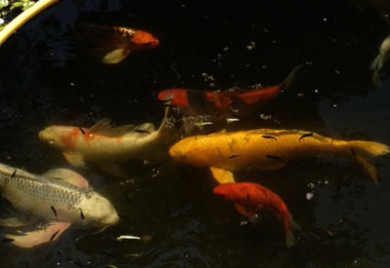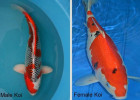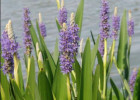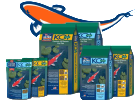Koi – 101: Top Koi care questions

Koi – 101
Top 12 Koi care questions
Everyday here at our pond supply and water garden supply store we get a lot of questions about Koi care. I wanted to take a moment and answer the top “12 Koi Care Questions”. Hope this helps and don’t forget if you have any questions, please stop by our local pond supply store where you can view a large variety of pond supplies and pond plants.
1. Maximum life span is over 100 years in exceptional cases; average life span is usually 25-35 years.
2. Maximum length is about three feet. Koi will reach 18 inches in three to four years, depending on the pond size, food and water conditions.
3. We feed our fish once or twice per day depending on the season. Koi can go ten or more days without food without harm. They will eat almost anything, but we feed them pellets that are specially formulated for Koi. These pellets come in different sizes and varieties. Koi can also be fed dried or fresh shrimp, lettuce, cooked rice or cooked oats.
4. Some of our fish are imported from Japan by air freight. The rest of our stock are the results of our own breeding operations here in the US. Koi are transported in plastic bags with water and oxygen and packed in cardboard boxes.
5. Our ponds are not heated, but the water is constantly aerated and filtered. Our filters are cleaned regularly even though the pond water appears to be clear.
6. The selling price of Koi is determined by size, body shape, color, pattern, and availability. Small Koi can start at $5.00 and champion Koi can be insured for a million dollars
7. Koi can withstand a wide range of temperature, but sudden changes in temperature are not good for them. They can survive under the ice in extreme cold as long as the water does not freeze solid. Koi are less active and eat less in cold water. They can live in the desert heat of 120 degrees as long as the is enough aeration.
8. Some individual fish just inexplicably die, but overall, Koi are remarkably hardy and healthy fish, much more so than goldfish or tropicals. Chlorine or chloramines in the city water and windblown insecticides are very dangerous to Koi. Smaller Koi have a much higher mortality rate than larger Koi and are more susceptible to diseases and changes in environment.
9. Koi get along well with goldfish and other tropical fish, as long as the other fish are not aggressive or small enough to eat.
10. Koi are not live bearers but lay thousands of eggs in a single breeding. Koi must be at least three to four years old and of sufficient size before they breed. Koi require special water conditions and environment before breeding. The eggs and baby Koi must be separated from the adult Koi or they will more than likely be eaten. The baby Koi hatch in about 3 to 7 days depending on the weather. The survival rate for baby Koi is less than 50%.
11. There are several color varieties of Koi, each with a different name. Koi with more than one color are unique in that there are no two that look exactly alike.
12. Raising Koi can be a fascinating and relaxing hobby. For the avid Koi enthusiast, there are Koi shows in which Koi compete according to their size and class.

Koi, Large koi, butterfly koi, koi for ponds
Pond Talk: Koi – 101: Top Koi care questions
Source: Sunland Water Gardens
Author: Jacklyn Rodman





